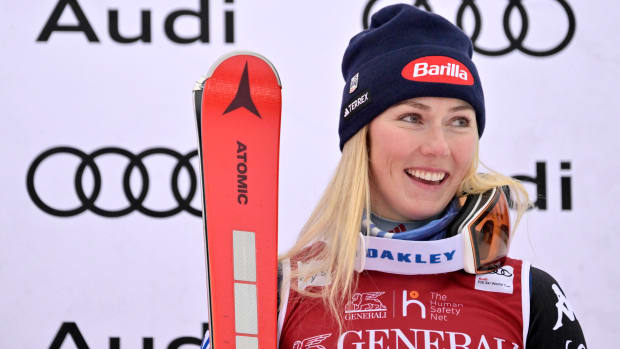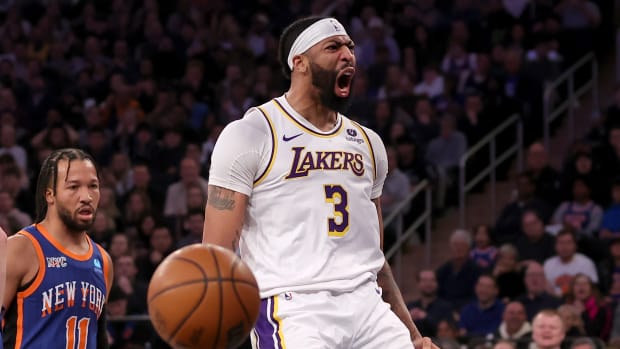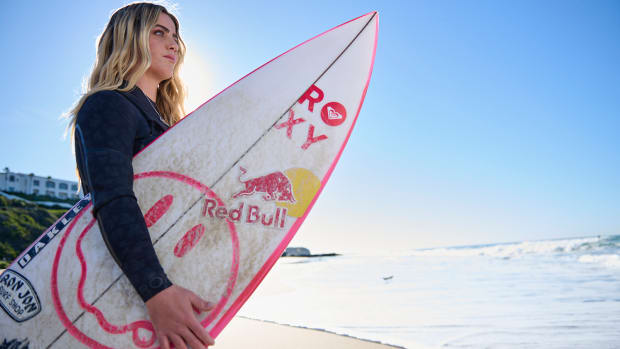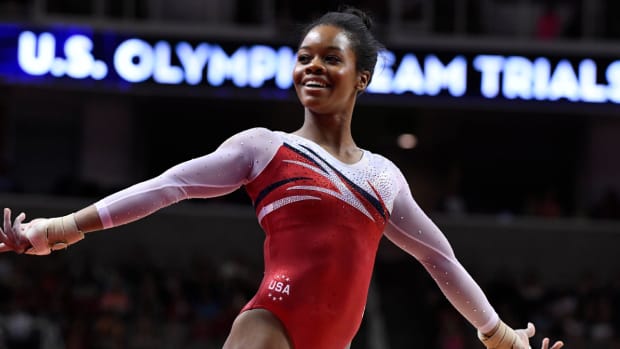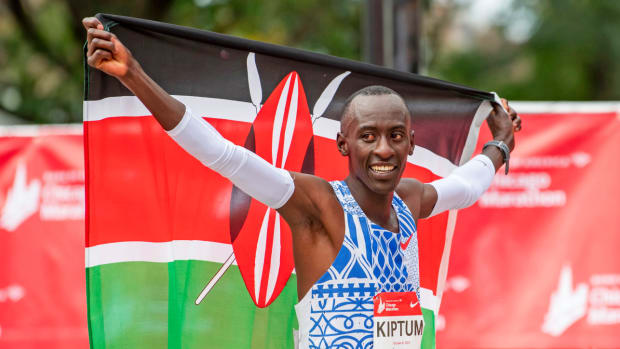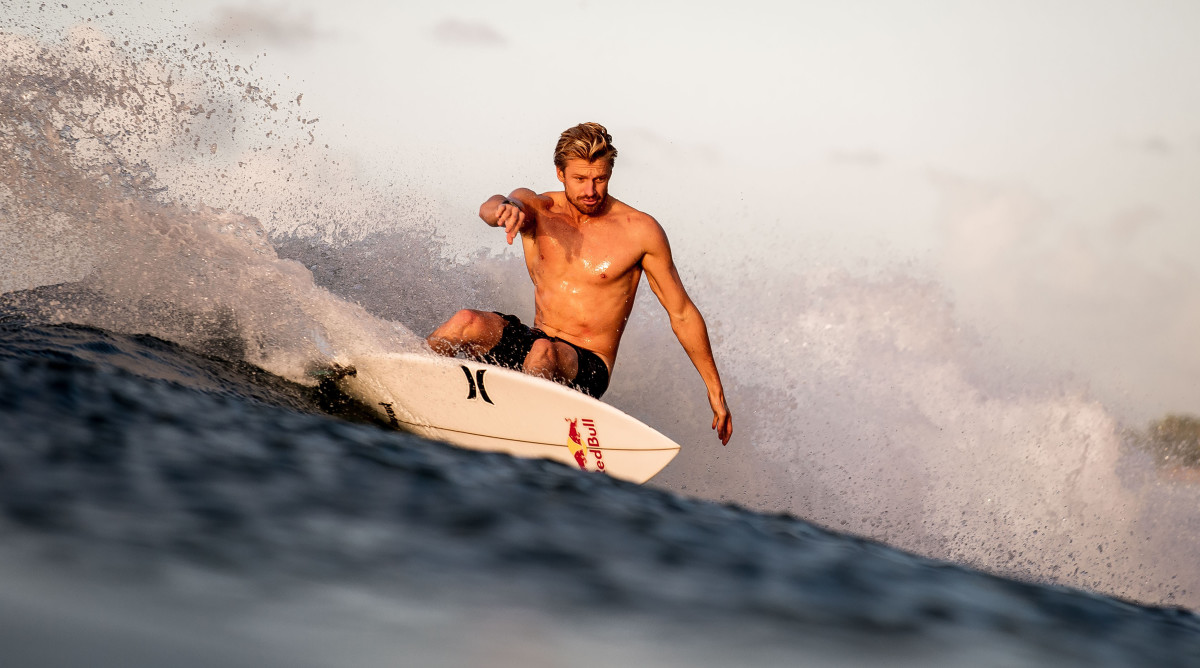
Healthy and Healed, Kolohe Andino Is More Ready Than Ever for Surfing's Olympic Debut
The Olympic surfer fidgets on the warning track in centerfield, all but beckoning for a fish-out-of-water joke. Someone hands him a microphone. Someone else reminds him to say Dodger, not Dodgers. His wife—pregnant with their first child, cell phone held high to capture the moment fast approaching—flashes a thumbs up.
Kolohe Andino seems to sense the pressure that’s accumulating, the slow build that can accelerate anxiety, that sometimes makes thinking clearly feel impossible. This is a simple task, on a Friday night in May, when Andino will say five words—it’s time for Dodger baseball—to a limited-capacity crowd. But Andino knows better. He knows himself, how his brain works. Simple does not equal stress free. He loves the Dodgers and had bugged out at the sight of their World Series trophy in the team lobby; that’s his friend, Chris Taylor, moonlighting in center. What if he screwed up?
He stops, at once surrounded and alone. Anyone watching closely can notice the deeper breaths, the centering, the intention. Andino smiles.
He’s ready. Ready for the Dodgers game, the crowd, the Jumbotron. Ready that same week to paddle back into the ocean after a four-month layoff to rehab an injured ankle. Ready for the gender reveal that’s scheduled for the next afternoon at their home in San Clemente. Ready for Tokyo and two Olympic debuts—surfing’s and his own.
Andino is prepared now for anything, really, after embarking on a self-actualization quest six years ago. First, he was the son of a surfer; then, the boy who followed dad into the water; then, alternately, a prodigy, a head case and a disappointment, still elite but with vast potential unfilled.
None of that matters on the perfect day at Dodger—no s—Stadium. Not with the sun shining, the flags flapping and the groundskeeper riding by on an oversized mower, his mask stamped with a fake mustache. “Babe, this is so cool,” Andino whispers to Madison, his wife, as “The Star-Spangled Banner” begins to play. The surfer who loves the anthem and America, takes his hat off and places his right hand over his heart. He’s wearing Dodger blue not just for Taylor, his occasional student, but in the hopes of sending the universe a message for the reveal.
“I love this,” says Andino, now the picture of a man on the precipice of something he does not yet recognize. He has no idea how dramatically his life is about to change. He only knows how drastically it already has.
Andino cannot pinpoint exactly when his relationship with surfing teetered. But if he’s looking for one date that encapsulates the lowest points, he could do worse than Sept. 11, 2015. By that point, at a World Surf League (WSL) competition in Trestles, Calif., the insular ocean community he inhabited seemed to collectively delight every time he lost his temper, which happened often enough to spawn video montages of his tantrums.
For this particular competition, the Hurley Pro at Lower Trestles, Andino climbed atop a white board wearing a black jersey. He wanted desperately to win at what amounted to home breaks. But when Mick Fanning, his surfing hero, received what Andino considered egregiously favorable scores from the judges, Andino spent the 20 minutes remaining in their heat floating in the water, middle fingers turned upward and pointed at the scorers.
How in the world had he ended up there, in front of friends and family, immersed in a remarkable meltdown? He had grown up nearby in San Clemente, the sun-splashed beach oasis a short drive up the coast. His parents had named him Kolohe, which means rascal in Hawaiian. And his father, a pro surfer who remained in the industry after retiring, had given him an ideal childhood. Wake up at sunrise. Surf at dawn. Eat. Train. Maybe sneak in an evening session. Then repeat, for years on end.
Andino rode his first wave after he could crawl but before he could really walk. His father, Dino, called the boy “Brother” and brought him everywhere, introducing him to legends like Andy Irons, Taj Burrow and Kelly Slater. Dad wanted son to love the ocean just as much as he did. But the rascal exceeded any reasonable expectations. He won his first contest and his second and no matter how high he ascended, or what age group he competed against, he dominated. As part of surfing’s older generation, Dino did not teach Kolohe all the acrobatic, gymnastics-like moves that would change the sport forever. Then he returned from one brief trip overseas and his boy had already mastered them. He was 12 and had picked them up in a matter of weeks.
The boy came to fancy the waves so much he had to be hauled out of them; he would have rented an Airbnb in the ocean if he could. Surfing became less of a hobby, like Kolohe’s forays into basketball and football, and more of a way to define both his idyllic childhood and a family’s soul. It came easy. It was gloriously uncomplicated. For a while, anyway.
The term both Andino’s now disdain started being floated around then, in the mid-2000s. Kolohe cannot recall the first time that he heard it, only that it bothered him, because it implied that he hadn’t worked hard or didn’t need to. “Like you can just sit down and play Beethoven,” he says.
The company that Dino worked for, Oakley, would sponsor his son. That meant he could bring Kolohe to even more events, to Australia, Mexico and France, only now with a dual purpose. But the considerable attention started to feel like a weight that Kolohe was forced to carry, and the “prodigy” label started to, Dino says, “become like a jinx.” Somewhere in there, between age 12 and the whole double-bird episode nine years later, surfing morphed into a job. That meant pressure. Expectations. And, eventually, meltdowns for positive results that were simply not good enough for him.
Dino tried playing amateur psychologist, telling his son to relax and ignore the noise. But when Andino struggled, he punched his board; sometimes, so hard, he broke through. Eventually, these scenes were stitched into lowlight reels, which made Dino wonder: had he made a terrible mistake?
During his own career, Dino had turned his street smarts into an edge. He looked at elite surfers from seemingly perfect families and believed he would beat them because he had lived a harder life. If he didn’t, then he had failed. So while he cautioned Kolohe, he pushed him, too. Friends sometimes told Dino to sit down, shut up and relax. He never did. “I put a lot of that blame on me,” he says. “Because I was so competitive, so grind-y, and I felt so much pressure from him getting paid all this money and wanting him to perform.”
Kolohe’s extreme personality didn’t help. It wasn’t just with surfing. Whatever he did, read, or watched, he obsessed over. He dove deep into country music, deeper into the Dodgers, deeper still into the wider world of sports; so deep, in fact, that he should become a contestant on one of those Around the Horn-type debate shows.
His fixations came to include Madison, who worked at an Italian restaurant that Kolohe frequented just to see her. They started dating, but he vacillated between the man he wanted to be and the man he was. He went through a “party stage,” experimenting with alcohol. They broke up. His results dipped. “I had a skewed perception of reality,” Kolohe says. “[Deep down], I didn’t think I deserved all the attention. I wanted to do good so bad.”
An interested party reviewed the double-bird incident and wondered if he could help. After all, Eric Potterat worked as a high-performance psychologist for the Dodgers. Potterat believed that world-class athletes separated themselves as much with brains as bodies, a notion that champions across sports had started to embrace.
Andino carried purposeful skepticism into their first session, making excuses, falling into patterns of defensive behavior. He was only 21, still immature, still caught between reality and the ideal he had created in his own head.
Potterat prodded, gently at first, pushing the universal notion that all athletes struggle with the same themes on some level; that the struggle was part of what made them elite to begin with; and that by harnessing what made them great in healthy ways, they could unlock their highest potential. The best athletes addressed whatever had been blocking them, just like they overcame injuries, altered diets and tweaked biomechanics. He deployed a favorite metaphor, comparing Andino to a computer system with radical hardware, everything perfect except for an operating system that needed to be fixed.
Together, they compiled a list of goals and charted Andino’s progress. They developed routines for training, and for nights before and mornings of competitions. Potterat started introducing meditation, mindfulness and visualization techniques, hoping that Andino would come to value process over outcome. “There’s a reason you fell in love with surfing, right?” Potterat said. “You’re an artist on the water. You can create and leave your board print on a wave. But that needs to be reinforced, where you can go out and have fun, not have to win at all costs.”
Andino went searching for that inner artist, the kid who simply loved to paddle out, at once a veteran of his sport and a newbie learning how to exist in a healthier way. He quit drinking and started dating Madison again. Progress wasn’t even, or tidy. More focus meant a renewed emphasis on training, a desire, he says, “to go all in.” But Andino took even that extremes, training too much. “For so long, his life was just about surfing,” she says. “Nothing else mattered.”
The focus Andino had fought for needed to be deployed in a more holistic way. He wanted to become a better boyfriend, a better human. He introduced a paleo diet, downing veggies and eating mostly vegan, and implemented more consistent sleep patterns. The more he opened his mind to change, the more he actually did. He still struggles with the magnitude of his life, all the pressure and expectations. But as he broadened his approach, making surfing part of rather than all of his existence, he learned how to better “control failure.”
Thus his widening love for baseball. His favorite players failed constantly and still went back. That was surfing’s core, anyway, a sport with so many variables—weather, waves, kismet, competitors—that extended far beyond what he could control. Andino needed to forget all that and let the artist make his art. He needed to ignore the past, the flip-offs, the boards broken, and live nowhere except right here, right now.
Eventually, Andino found solace outside of surfing. Like in the dry sauna at his home. Or in sports other than his own. Sometimes, the two converged, like when he befriended the NFL quarterbacks who trained nearby, which is how fellow San Clemente native Sam Darnold ended up in that sauna, the temperature cranked over 200 degrees. In yet another exercise in extremism, Andino would refuse to leave the sweatbox until everyone else had bolted; to hasten their departures, he kept pouring water on the rocks.
Like most locals, Darnold knew of Andino’s reputation as a “head case, for lack of a better term.” But the person he wilted with seemed different, more evolved and still evolving. As Darnold struggled to match his own massive expectations—taken third-overall by the Jets in 2018, before injuries and a rebuilding roster conspired for an uneven start—the two held long discussions over what mattered most. The “glow” that Darnold’s new teammates in Carolina describe started there, with introspection and an emphasis on mental health from two athletes who understood each other in a way most of the world never would understand either of them. “The pressure, especially at a young age, of having to win right now,” Darnold says.
The twist: Andino was more into sports, meaning he debated NFL rosters incessantly. He pestered Darnold for fantasy football tips and sent glowing reviews over text message of the quarterback’s new center, Matt Paradis—a “real beast,” apparently.
Dino decided to watch his son at more of a remove. They remained neighbors and best buddies but drew a clear line of demarcation, deciding that Kolohe, now 27, should shape his own expectations and handle his own progress. Kolohe thinks his father has been too hard on himself and says he holds no resentment from childhood.
The progress that Andino made with actual surfing was immediate. Ranked 31st at the time of the two-finger meltdown, in danger of losing his tour spot, he ascended rapidly to fourth in the world by the end of ’15. This was—favorite word—rad. Better yet, Andino maintained momentum, all but buying a residence inside the top five. “This kid,” Potterat says, “is gonna be a world champion.”
Still, doubts lingered from outsiders who wondered how Andino would handle his next noteworthy setback. Like, say, a global pandemic that upended his season and delayed his Olympic dream. Rather than wallow, though, the surfer pivoted, on instinct, thanks to a right knee injury that freed up his January in 2020. He purchased old-fashioned equipment, like a 16-millimeter movie camera, gathered a group of friends and left for a boat trip to the Mentawai Islands in Indonesia. He stayed for seven weeks that further transformed him.
For an amateur psychologist—and his family members—there seems to be something deeply spiritual in play there. Andino broke from competing only to stay in surfing for the next six months. He set up behind the camera, rather than in front of it, to tell stories about others rather than have stories told about him. He made a film, titled “Home-ish,” immersing in editing and production. The group ended up filming in France, Portugal, Hawaii and California, and the elongated trip meant an expanded project—On The Side—that Andino released in three parts last November.
The storyboard for the film rests on a couch in his upstairs hangout cave, with hardly a trophy in sight. Andino describes the cinematic style as “surf porn, for lack of a better phrase,” and it is stunning, truly, the double-decker-bus-sized waves, the impossibly blue water, the tunnels surfers shoot through, the crazy turns they make. His imprint is all over the film and yet he’s hardly featured. He does compare going through a barrel of a wave on a surfboard to “natural drugs, like you’re barrel drunk.” It plays like a love letter to his sport—the one he loves again.
“A masterpiece,” says close friend and former manager Brandon Guilmette. And, more proof of the evolution.
The film layered in even more perspective, reminding Andino in the most cinematic way why he came to adore surfing in the first place. It wasn’t the accolades, wasn’t the glory and sure as hell wasn’t the expectations. It was everything he captured in that documentary, like the sequence he shows off, of his friend cruising through “this crazy, huge barrel” in the grainy footage captured by an Olympian turned documentarian. “It’s like, this is the way that surfing is supposed to be,” he says. “It’s an expression of who we are.”
The process worked in a circular nature, making Andino feel “more human and more connected”—the two things that made him want to surf again and gave that romantic feel he had lost along the way. So when he did come back and qualify for the Olympics, beating out Slater for the second male U.S. slot, not even the injured ankle could derail Andino’s progress. As much as he missed the water, he had more time to edit and a family of his own to build. Potterat watched the surfer who entered his office a cynic and saw maturity, gratitude, growth.
“Now,” says Darnold, “it’s time.”
Inside the man cave in San Clemente, the changed surfer considers his choppiest waters compared to now. There are vegan tacos on the table, two labs scurrying by, workout gear lying near camera equipment and an American flag hanging on the wall. This is his new life—healthy, familial, balanced and patriotic—in one image.
Throughout his childhood, Andino fixated on the Olympics, spending hours in front of the TV every two years. The necessary dedication—entire lives dedicated to one pursuit—fascinated him. Andino can still vividly recall his favorite moments: Michael Phelps by a fingertip in Beijing; Jessie Diggins by a ski in South Korea; Usain Bolt, always; Shaun White, for crossover dominance. Andino fell in love with biathlon, from the combination of skills to the inherent difficulty in racing, then stopping to shoot at small targets. “It’s like an ancient hunter/gatherer sport,” he says. “Like they’re running from a saber-toothed tiger and have to stop and shoot the squirrel for dinner.”
Sometimes, he imagined what it might be like to compete for America, visualizing the medal ceremony before he had learned visualization techniques. He told himself he would become an Olympian, before he knew anything about speaking his goals into existence. There remained but one problem: surfing was not an Olympic sport.
Perhaps it’s a manifestation of destiny, or nothing more than a delightful coincidence, but surfing did make the Olympics, which meant Andino could, too. After making the team, his Instagram post from the Fourth of July wished his country a happy birthday and went on about his pride in being American. But the three quotes he added at the end of the post led to a divide, heavy criticism balanced with high praise. One citation read: “Equal rights for all, special privileges for none.” —Thomas Jefferson
The important part, for Andino, wasn’t the outside reaction. It was his. He didn’t let the mild controversy deter him from his path toward surf enlightenment. He also didn’t worsen the saga. There’s a word for that: growth.
Andino sees that everywhere, in all facets of his life. Rather than over-train, he shifted time and energy toward recovery after he injured that ankle. He started seeing Drew Morcos, founder of MOTUS Physical Therapy, sneaking in a second session most days.
Morcos compares the surgery Andino underwent to fix his high ankle sprain to the same TightRope procedure that Tua Tagovailoa underwent at Alabama. Rather than screws, doctors secured metallic buttons against the tibia and fibula, speeding up the healing time. Morcos didn’t want to rush Andino back, but after months of rehab and recovery, he had healed for a safe return. This marked the latest step in his transformation. “It finally clicked to him,” Morcos says, “where, I have to take care of my body and make everything else work.”
In June, Andino drove down to the beach by himself. He climbed back in the water. Paddled out, into the waves. He told his wife how much it meant to him—gratitude. He told his physical therapist he had never felt better—appreciation. He told his dad he was ready—setting an obtainable goal. Earlier that same week, the Andinos revealed to 40 or so friends and family that they’re having a girl in December. Kolohe wanted a boy but accepted the news easily, with grace. “He just has a different glow,” says Guilmette, the former manager.
Now, the Olympic dream draws near. Healthy and healed, Andino must prepare for the smaller waves in Japan, breaks that will introduce more variables. He affixed an American flag sticker to his favorite board. He wants to win, but that’s no longer the only goal, just an important one. It’s a small adjustment that makes an enormous difference, now six years in the making.



